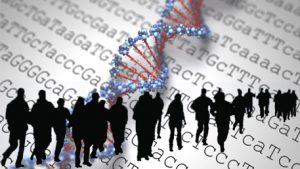From Genes to Public Health: Building the Evidence Base for DNA-based Population Screening
Posted on by This blog post is a summary of our recent commentary in Genetics in Medicine. The use of genetics in population screening long predates the Human Genome Project. For more than 60 years, newborn screening has been a successful public health program that has resulted in major improvements in outcomes for infants with genetic and other conditions. Recognizing the emerging role of genomics as a population screening tool across the lifespan, Evans et al. called in 2013 for scientific investigation of DNA-based screening in adults. In the United States and other counties, the vision of DNA-based population screening has begun to be realized in multiple health systems, population-based biobanks and learning health systems research settings.
This blog post is a summary of our recent commentary in Genetics in Medicine. The use of genetics in population screening long predates the Human Genome Project. For more than 60 years, newborn screening has been a successful public health program that has resulted in major improvements in outcomes for infants with genetic and other conditions. Recognizing the emerging role of genomics as a population screening tool across the lifespan, Evans et al. called in 2013 for scientific investigation of DNA-based screening in adults. In the United States and other counties, the vision of DNA-based population screening has begun to be realized in multiple health systems, population-based biobanks and learning health systems research settings.
Recently, the American College of Medical Genetics and Genomics (ACMG) published two guidance documents on DNA-based screening of healthy adults. The first document has seven points to help guide programs and sponsoring organizations. The documents review the evidence around DNA based screening in relation to the well-known Wilson and Jungner criteria for screening. The document concludes that DNA-based screening risk identification should be effectively combined with evidence-based risk-reducing clinical care. The document embraces the list of genes associated with the CDC Tier 1 genomic applications as a core list for consideration in the context of population screening.
The second document is addressed to individuals and healthcare providers. It acknowledges at the outset that while the clinical utility of genome sequencing in apparently healthy people has not been established, accessibility to sequencing has increased, including use by the public without any specific clinical indication. The document explores opportunities and challenges presented by the changing models for delivery of genetic testing services. These include: 1) traditional genetic healthcare model of services between genetics healthcare providers and a patient’s referring provider; 2) a non-traditional genetic healthcare model where genetic services are integrated within primary care and other specialties; and 3) a consumer-directed genetic healthcare model in which consumers initiate the process on their own without involvement of healthcare providers. The document offers a framework for the delivery of DNA testing according to the well-known pre-analytical, analytical and post-analytical phases of the testing process.
The two documents taken together highlight the importance of an evidence-based approach to population screening and promote integrity, quality and outcomes of the testing process. However, as the first ACMG document clearly shows, there are key knowledge gaps in fulfilling criteria for population screening. One important gap is the incomplete understanding of the “natural history of the condition.” While we have a detailed understanding of many genetic conditions in patients identified by diagnostic testing, natural history data are still emerging for persons identified via DNA-based screening. If DNA-based screening is to improve the public’s health, it must be combined with evidence-based care that reduces the burden of disease. Guidelines will need regular re-analysis of DNA variants, regular evaluation in screened individuals, updated clinical decision support tools and linkages with electronic health records, as well as ongoing assessment of benefits and harms of screening.
We have previously proposed a collaborative implementation research agenda embedded in learning health systems to create an adequate evidence-base to support DNA-based screening to improve population health. The agenda outlines collaboration among multiple health systems with available genome sequencing data and clinical outcomes. It calls for evaluation of the impact of genetic information through research that is based on level of evidence for each intended use (tiers). Both observational studies and randomized controlled trials may be required to adequately evaluate health benefits, harms, and costs based on returning or not returning the results of gene variants to patients and providers. More efforts are needed to engage public health systems, professional societies and healthcare organizations in the dialogue around DNA-based population screening.
Posted on by


